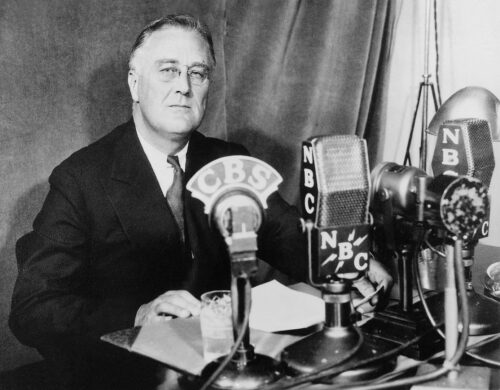Your First 100 Days and What to Do with Them
October 2, 2023

When Franklin Delano Roosevelt took office on March 4, 1933, during the darkest and most desperate depths of the Great Depression, he revived a phrase that had been born on February 26, 1815, when Napoleon returned to France from his exile on the island of Elba. For the next hundred days, he led a stunning military campaign to regain his conquest and his throne. Napoleon singlehandedly rebuilt an army of 250,000 and very nearly succeeded in retaking his lost empire. Of course, it all ended badly for him a hundred days later at the Battle of Waterloo, on June 18, 1815, yet “The Hundred Days” became a phrase that has continued to echo down through history. FDR picked it up 118 years later and put it on himself.
Immediately after his swearing in, President Roosevelt summoned Congress to convene in a three-month-plus special session, during which he presented and gained passage of fifteen precedent-shattering, precedent-making bills, enacting programs aimed at gaining relief from the Depression. Goaded and guided by the president, Congress passed a grand total of 77 laws in the space of 100 days. For those keeping score, that’s 0.77 laws per day. It was all too necessary, because the United States of America, like much of the world, had become what students of business catastrophe like to call a “burning platform.”
Not everybody thinks everything FDR and Congress did in The Hundred Days was good, but even the critics and outright haters admit that something had to be done, and, to this day, the performance of each new occupant of the White House has been judged in some measure on what they achieved or failed to achieve in their First 100 Days. I’ve never had presidential ambitions—If nominated, I will not run. If elected, I will not serve—but, as Roosevelt borrowed from Napoleon, so I shamelessly took from Roosevelt when I was called on to take serve as CEO of a platform that, while not yet aflame, had begun to smolder. I wrote a letter to the executives and managers of the organization in which I outlined what I intended to do with the First 100 Days of my administration. There were four steps:
Step 1: Set a goal.
- Mine was an ambitious whole-of-company goal to reach $2.2 billion in revenue with 18% margins and $400,000,000 in EBITDA within the space of three years. So, in the very first minutes of those 100 days, I articulated the goal of a three-year plan. This, in turn, implied a more immediate goal, which was taking the steps necessary to turn the business around, positioning it to earn the right to grow. As I wrote in my letter: “We will begin by simplifying our business. The executive team has reviewed what to stop, start, and continue doing immediately to get foundationally solid; we will communicate that shortly.” I explained that we would collect and use “data to determine where to simplify and grow the business by determining where to raise prices to increase our bottom line.”
Step 2: Create the strategy.
- The next step, which would span the first 100 days, would be to build a strategy to allow the company to achieve the new three-year goal. We would use the 80/20 Principle to identify the roughly 20 percent of what we were doing in our business that was producing 80 percent of our profit. Knowing this would enable us to separate what was working from what was not working. Going forward, our decisions would be based on this data-backed knowledge. My most immediate message, however, was that we would have our new roadmap—our new growth-directed strategy—within the first 100 days.
Step 3: Build the structure.
- I already knew what we needed to achieve in reorganizing the company. Our business needed to be strategically segmented to focus on creating great customers, innovating new products, and, most of all, meeting our three-year financial goal. The segments of the redesigned business would be organized in a rational structure with provision for accountability for delivering our goals.
Step 4: Launch the action plan.
- While I had already promised delivery—in the First 100 Days—of a new strategy capable achieving the three-year goal, I sought to instill in the organization a bias for action. I wrote: “We’ll define the tactics and efforts to execute the plan. We won’t wait for perfection here. We’ll make sound, informed decisions and go.” In effect, even before the end of the 100-day period, we would be putting together a rough-draft action plan that would allow us to make positive decisions and initiate needed actions as soon as possible. The watchword was progress not perfection.
The “action plan” really was an outline for actions to be taken during the First 100 Days. Functional managers throughout the company would focus on drawing up action plans for executing the “critical few” objectives in their areas of responsibility, objectives that addressed the 20 percent of customers and 20 percent of products that produced 80 percent of our profit. In parallel with this, upper-level executives would press ahead with the overall, companywide strategy. A working version of the strategy would be completed by the end of the first 100 days, but the full Strategic Management Process would require a year, a journey through all four reporting quarters, to bring to its first maturity. This would be the process we intended to ride the rest of the way to our three-year goal.

Franklin Roosevelt had his celebrated Fireside Chats, in which he talked to the American people in a frank and friendly manner via radio broadcast, sharing with them the government’s short-term and long-term plans. In our company, we had Townhalls rather than Fireside Chats, in which executives and managers at all levels came together. The first town hall kicked off the First 100 Days. At the end of the month one, we convened another townhall to review and measure our progress, to monitor our course, and to make any necessary corrections. As in the first town hall, the second half of the meeting was devoted to questions and answers. The third meeting came very near the end of the First 100 Days and coincided with the end of the first quarter, which is the regular occasion for reports and evaluation. In this way, the First 100 Days merged naturally with the regular running of the business. Yet, unquestionably, everyone understood that, by this point, we had introduced something entirely new into the business: a complete strategy and process for a turnaround intended to earn us the right to grow.
